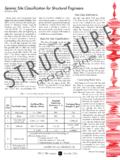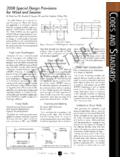Transcription of Reducing Embodied Energy in Masonry Construction
1 Sustainability and preservation as they pertain to structural engineeringStructural SuStainabilitySTRUCTURE magazineMay 2010 STRUCTURE magazine8 Reducing Embodied Energy in Masonry ConstructionPart 1: Understanding Embodied Energy in MasonryBy Vivian Volz, RA, CSI, CCS, LEED AP and Eric Stovner, , LEED APAs clients and the public grow ever more aware of climate change, design teams are increasingly concerned about the environmental impact of buildings and the materials used to make them. Green design and Construction are no longer the exclusive realm of activists. The construc-tion and operation of buildings actually have a far greater impact on the Energy used in the US than automobile travel, accounting for over half of the Energy used annually. Whether out of concern for greenhouse gas emissions, for conservation of fossil fuels, or for Energy independence, project teams are beginning to share an expectation that they should decrease the total Energy consumed during a building project s life cycle.
2 On their own or at the behest of architects and owners, structural engineers are stepping up to participate in the committed to the 2030 Chal-lenge and AIA s 50to50 design strategies are asking all of their consultants, includ-ing structural engineers, to find ways to improve their projects life cycle Energy performance. The 2030 Challenge is a call to action for architects to reduce the Energy impact and carbon footprints of their projects, targeting zero-carbon proj-ects by the year 2030. The AIA s 50to50 design strategies are a set of design concepts and tools that may help the design team reduce the carbon and Energy impacts of projects. Both movements emphasize engaging the whole project team in the shared goal. As Dirk M. Kestner, , LEED AP, wrote in STRUCTURE (June 2009), As structural engineers, we must not be passive in understanding the impacts of our materials. The stated goals of the 50to50 and 2030 Challenge movements focus on the reduction of buildings carbon footprint.
3 Carbon footprint is determined by measuring the greenhouse gas emissions of a process in terms of an equivalent mass of carbon dioxide. Different methods of Energy production have different car-bon footprints, with the largest resulting from fossil fuel burned for Energy is a major source of greenhouse gases, man-ufacturing processes can also absorb or release greenhouse gases, independent of the Energy used. For instance, timber growth absorbs carbon dioxide, but port-land cement emits carbon dioxide during firing as part of the calcination process, at a ratio of nearly a pound of carbon dioxide for every pound of cement is worth noting that Energy and carbon footprint are related, but are not exactly the same thing. For manufactured prod-ucts, it is useful to consider not only the carbon footprint of the product, but also its Embodied Energy , the Energy used during manufacture of a building Energy can be considered sepa-rately from the Energy used during the operation of the finished project.
4 Expressed in Energy by volume or Energy by weight of a building product, typical values for basic building product classes can be found using NIST s BEES program, the Athena Institute s Impact Estimator and EcoCalculator, and other life cycle assessment tools. Products and systems that have good potential to improve the operating Energy performance of a build-ing may, nonetheless, have a negative net impact because of high Embodied Energy . As the operational Energy use of a project decreases, the Embodied Energy becomes an increasingly important component of the total Energy impact of the two-part series of articles will ad-dress the two problems structural engineers face in evaluating new Masonry products. In the first article, the Embodied Energy impact of traditional Masonry products will be explored, and newer, lower- Energy materials will be introduced. The second article will offer a set of evaluation criteria for new Masonry materials, including both standard performance metrics and environmental simplicity in comparing materials, this article will use one primary metric: Embodied Energy by volume.
5 In some cases, the functional unit of measurement commonly used in life cycle analysis is weight, so some products will be com-pared by weight. Cases where the carbon footprint of a material diverges dramati-cally from its Embodied Energy will also be Problem: Traditional Masonry Takes A Lot Of Energy To ProduceMasonry systems, while they can be beneficial in terms of operational Energy , possess significant Embodied Energy . Depending on their thickness and the climate, Masonry assemblies can vastly improve the Energy performance of a fin-ished project by virtue of their thermal mass. By absorbing Energy by day and releasing it at night as radiant heat, Masonry assemblies can reduce temperature swing and maintain thermal comfort with less The fly ash brick manufacturing process does not use ovens, removing a major source of Embodied Energy and greenhouse gas T R U C T U R E magazineCopyrightMay 2010 STRUCTURE magazineMay 20109need for heating and air conditioning.
6 How-ever, the materials in these assemblies can take enormous amounts of Energy to brick is a fired material. Firing causes vitrification of the clay into a crystalline or semi-crystalline structure and is the process that gives clay brick its strength and stability. In the US and Canada, most kilns are tunnels, operating continuously at 1090 C (2000 F) while the bricks are slowly conveyed through. Even when volume is low or no bricks are being fired, the kilns are kept hot. BEES data puts the Embodied Energy of fired clay brick at MBtu per cubic yard. With advances in Energy reclamation and more efficient kilns, the brick Industry Association now states its average is 1239 BTU per pound, or MBtu per cubic yard. This Energy would fuel the average American home for four cement is also a fired material, made by crushing and firing limestone. The Embodied Energy of portland cement is MBtu per ton. While the cement itself is a small proportion of concrete Masonry units, the extraction and crushing of aggregate also consumes Energy .
7 However, the aggregate has a much lower Embodied Energy , about 19,900 Btu per ton for sand and gravel, and about 30,500 Btu per ton for crushed stone. Thus, the Embodied Energy depends largely upon the proportion of ce-ment to aggregate in a given concrete mix. The Embodied Energy of concrete brick is MBtu per cubic yard. The typical Embodied Energy of CMU is MBtu per 100 units, which contain about a cubic yard of concrete. For both Masonry products, portland cement accounts for 83 percent of the Energy needed for the entire production process, but makes up less than 15 percent of the the main source of greenhouse gases emitted during clay brick production is Energy production, clay brick s carbon footprint is almost entirely due to its high Embodied Energy . On the other hand, portland cement products carbon footprints result, in part, from the cal-cination of the limestone feedstock, a chemical process that releases carbon dioxide.
8 The only way to reduce the calcination impact is to reduce the quantity of portland cement used. For a cubic yard of each material, the carbon foot-print for fired clay brick is 991 pounds and for concrete brick is 572 materials used in Masonry design can also have significant Embodied Energy profiles. Stone occurs naturally, but takes a great deal of Energy to extract, is in limited supply and is not renewable. Some traditional materials, such as adobe and terra cotta, have considerably lower Embodied Energy , but they are lower-performing from a structural perspective and are beyond the scope of this article. Mortar, a smaller part of the structure, also contains portland cement and has Embodied Energy similar to that for concrete. New steel is a relatively small proportion of a reinforced ma-sonry assembly, but is a high- Energy material. Greener Materials: New Materials with Lower Embodied EnergyEngineers can make a difference in their projects Embodied Energy with lower-impact material choices.
9 This article will focus on so-lutions that can reduce the Embodied Energy of the most common systems, brick assemblies and CMU BrickBrick can be reclaimed during building de-molition. While arguably the lowest- Energy means to procure brick for a project, reclaimed brick is usually difficult to match, both in aesthetic characteristics and performance char-acteristics. It is most appropriate for projects with a deliberately rough Fired Clay BrickRecent advances in firing technology have reduced the amount of Energy used by kilns. For instance, some manufacturers capture waste heat from the firing and cooling chambers and use it to warm the drying chambers. Advances in alternative Energy , such as waste-to- Energy and captured methane from landfills, may reduce the use of fossil fuels and the release of greenhouse gases, without actually Reducing the amount of Energy used. Smokestack scrubbing technologies also reduce the release of smog-producing gases.
10 The fact remains, however, that there currently is no way to reduce the amount of heat required for firing standard clay. Individual brick plants may use some-what less Energy than the industry average. Bricks made in the UK with recycled glass, while still fired, may offer lower- Energy alternatives in the MixturesThe Embodied Energy of a mixture can be reduced by replacing part of the portland cement in the mix with supplementary cementitious materials. For example, Type C fly ash and blast furnace slag are both post-industrial recy-cled materials that have cementitious qualities. These and other admixtures, such as Type F fly ash, are also pozzolans; they react with the by-products of portland cement hydration to form additional cementitious bonds. Because they are created in other industrial processes, the environmental impacts of fly ash and blast furnace slag are assigned to those processes, not to the products into which they are recycled.



















